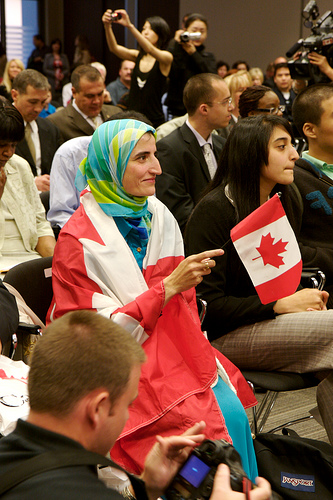 In 2013, the Canadian government’s attention will once again be focused on the Arctic. One immediate priority is the upcoming decision by members of Stephen Harper’s cabinet on how to conduct an environmental review for aproposal to develop the Izok Corridor in Nunavut.
In 2013, the Canadian government’s attention will once again be focused on the Arctic. One immediate priority is the upcoming decision by members of Stephen Harper’s cabinet on how to conduct an environmental review for aproposal to develop the Izok Corridor in Nunavut.
The plan – put forward by a company headquartered in Australia, but which is a subsidiary of Chinese state-owned resource giant China Minmetals – could bring billions of dollars into the region through its production of an estimated 180,000 tonnes of zinc and 50,000 tonnes of copper a year.
Such production, however, is also slated to bring the development of substantial new infrastructure, including open-pit mines, roads, bridges, air-strips and ports, as well as a processing plant. This prospect has raised concerns about, among other things, the fate of the Bathurst caribou, already in a precarious condition, which reproduce on the same territory.
But the other, longer-term factor that is keeping eyes turned northward is Canada’s upcoming chairmanship of the Arctic Council, due to begin later this year. This intergovernmental body, created in 1996, includes a core set of Arctic states (Canada, the U.S., Russia, Finland, Sweden, Norway, Iceland, and Denmark), as well as six indigenous organizations, as permanent participants – an unusual configuration that owes much to Canada’s foundational leadership.The Canadian government would be wise to seize the opportunity of chairmanship to think creatively about the council’s role and the future of Arctic governance more generally, particularly given the interest of so many countries (including the Chinese) in the region’s resources.
The Walter and Duncan Gordon Foundation, based in Toronto, has developed a detailed and ambitious blueprint for what Canada might do as chair of the Arctic Council over the next two years. (Full disclosure: I was, until September, a trustee of the foundation.) Up until now, the council has focused primarily on environmental protection and sustainable development. Moving forward, however, there is opportunity for greater focus on issues related to security and emergency management, as well as better health and education for Arctic inhabitants.
There are three main sets of issues that could inform Canadian leadership over the coming two years. The first is organizational. The council faces that perennial problem of whether and how to expand its membership. While there are currently only eight member states, there are also official “observer states,” including, for example, France and the United Kingdom. To date, the process of obtaining observer status has been relatively ad hoc. But with a number of countries, including China, Japan, and India, expressing greater interest in the Arctic due to the potential for natural resource exploration and extraction, a clearer path to observer status is needed.
The council also needs to tackle the deeper question of whether it wishes to expand the number of permanent members. This move could have positive financial benefits, as with membership comes financial contribution. However, indigenous peoples are (naturally) concerned about opening the tent too wide, particularly to entities like the European Union, which protest seal hunting and the like. There is also suspicion about the motives of some would-be members, particularly when it comes to resource extraction. Indigenous peoples therefore insist that any new observers solemnly declare respect for two core principles of the Arctic Council: sovereignty of the Arctic, and the rights of Arctic indigenous peoples.
Canada would do well to stay clear of stale debates about who should be included and who should be excluded. Instead, as Finnish Foreign Minister Erkki Tuomioja has argued, the Arctic Council needs to become a model of 21st-century diplomacy and governance, where regional and global interests and responsibilities are combined in interesting ways. Our government can, and should, illustrate how this might be done. It could push for a more secure and sustainable funding mechanism for the Arctic Council, particularly to allow for continued indigenous participation (which is costly to maintain).
The second set of issues relates to resources. Given the effects of climate change, and a less “ice-bound” Arctic, new problems and pressures have arisen. One initiative Canada could push is the creation of an international Arctic fisheries agreement, which would protect the fragile polar ecosystem from unregulated commercial fishing in the high seas of the Arctic. At the very least, our government should insist on authoritative baseline studies of fish stocks. In addition, Canada can lead the council in what are bound to be thorny discussions about regulation of natural resource exploration and exploitation.
But the Arctic also includes valuable human resources – a fact too often forgotten. Here, a forward-looking Canadian government would make better health and education for Arctic peoples a key priority of its leadership of the council from 2013-15. This would also require putting any initiatives on a multi-year funding cycle, so that programs could build momentum.
The final set of issues, which perhaps has the greatest potential for innovation, encompasses infrastructure and security. As Canadians have learned through the fatal aircraft accidents of 2011 in Resolute and Yellowknife, search and rescue capability is vital to being a responsible Arctic power. The Arctic Council has enhanced emergency management through its Agreement on Cooperation on Aeronautical and Maritime Search and Rescue (the first binding agreement secured by the council), but Canada needs to invest in its own infrastructure to live up to the tenets of the agreement. Currently, it is the only Arctic coastal state without a substantial Arctic port, and its search and rescue facilities are thousands of miles from the Arctic Coast.
In terms of security, Canada should try to avoid inflammatory language about “conflict in the Arctic” (a favourite topic of pundits a few years ago), and think more strategically about how Arctic countries can co-operate in confidence-building exercises. These might include joint naval or search and rescue exercises. Rather than thinking of security in the Arctic in zero-sum terms, Canada could think of it in a way that is more in line with the Organization for Security and Co-operation in Europe’s conception of co-operative security.
Unfortunately, much of the Canadian government’s investment in the Arctic thus far has focused on sovereignty claims and military expenditure. While these have some merit, on their own they could send the wrong signal about the kind of Arctic power we intend to be. A wider and more multi-faceted agenda for leadership of the Arctic Council – backed up by rigorous scientific research – would better reflect the interests and values of Canadians, and contribute to future management of the Arctic’s resources. It might also be of greater interest to the United States, which will take on chairmanship immediately following us, in 2015. Indeed, governance of the Arctic could become a policy area shared by the U.S. and Canada, enhancing ties between our two countries.
Canada has two years to make its mark on Arctic governance. The clock starts in June 2013.
Jennifer Welsh is Professor in International Relations, University of Oxford and Co-editor (with Vaughan Lowe, Adam Roberts, and Dominik Zaum) of The United Nations Security Council and War: The Evolution of Thought and Practice since 1945, (Oxford University Press, 2008) and (with Ngaire Woods) of Exporting Good Governance: Temptations and Challenges in Canada’s Aid Program (Wilfred Laurier University Press, 2007).
This post originally appeared on opencanada.org, the website of the Canadian International Council. It is re-published here with the permission of the author.





No Comment